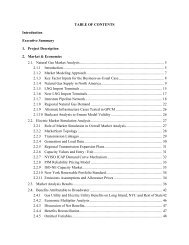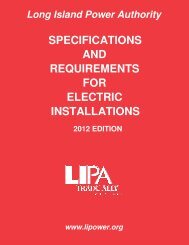Appendix E-2.c.i Energy Plan 2004-2013 Follow-up Studies and ...
Appendix E-2.c.i Energy Plan 2004-2013 Follow-up Studies and ...
Appendix E-2.c.i Energy Plan 2004-2013 Follow-up Studies and ...
Create successful ePaper yourself
Turn your PDF publications into a flip-book with our unique Google optimized e-Paper software.
Re-powering Study for the Northport <strong>and</strong> Port Jefferson Power Stations<br />
<strong>Appendix</strong> II Northport System Descriptions<br />
Industrial grade aqueous ammonia at 19% concentration is received by truck. A vapor return line from<br />
the ammonia storage tank back to the delivery truck provides venting of the tank during filling operations.<br />
A single storage tank provides five days of capacity based on full load operation of the particular option.<br />
From the tank, two 100% ammonia feed pumps convey the aqueous ammonia through a strainer to the<br />
ammonia vaporization skid for each HRSG. A self regulating positive displacement pump maintains the<br />
required flow <strong>and</strong> a constant pressure to a dedicated injection skid for each HRSG.<br />
The injection skid mixes the ammonia with high temperature flue gas drawn off the HRSG to vaporize the<br />
ammonia as necessary to obtain proper distribution into the exhaust gas via the ammonia injection grid<br />
located inside the HRSG <strong>up</strong>stream of the SCR. The injection skid includes two 100% blowers.<br />
2.11 Component Cooling Water<br />
Refer to P& ID 09-09A thru 09D in <strong>Appendix</strong> III.<br />
The CCW System s<strong>up</strong>plies cooling water to the steam turbine lube oil coolers, steam turbine generator<br />
hydrogen coolers, the combustion turbine(s) lube oil coolers, combustion turbine(s) generator hydrogen<br />
coolers, the sampling system sample coolers, <strong>and</strong> any other plant components that require cooling water.<br />
Two 100% capacity pumps provide the motive force for circulation of the closed cooling water to the<br />
system users. The pumps are horizontal, single stage, centrifugal pumps. Butterfly valves are installed on<br />
the intake <strong>and</strong> discharge of each pump. For pump protection, a check valve is installed on the discharge<br />
side of each pump. A fin-fan type heat exchanger is used to transfer CCW heat duty to the atmosphere.<br />
A surge tank is provided to allow for thermal expansion, <strong>and</strong> acts as a surge volume for the CCW System<br />
water. The surge tank, which is installed at the highest point in the system, also provides net positive<br />
suction head (NPSH) for the CCW pumps. The surge tank is equipped with level instrumentation, which<br />
provides signals to operate an automatic make-<strong>up</strong> valve. Make-<strong>up</strong> water is s<strong>up</strong>plied from the Condensate<br />
System.<br />
A chemical addition pot is installed for the addition of chemicals to control corrosion within the CCW<br />
System.<br />
The CCW System s<strong>up</strong>plies the following components with cooling water:<br />
• Steam Turbine Lube Oil Coolers<br />
• Steam Turbine Generator Hydrogen Coolers<br />
• Steam Turbine Generator Exciter Coolers<br />
• Steam Turbine Generator Seal Oil Coolers<br />
• Combustion Turbine Lube Oil Coolers<br />
• Combustion Turbine Control Oil Coolers<br />
• Combustion Turbine Starting Package Oil Coolers<br />
• Combustion Turbine Generator Hydrogen Coolers<br />
• Combustion Turbine Generator Seal Oil Coolers<br />
March 30, 2009 164






